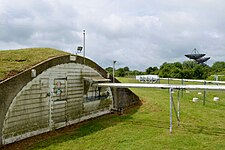Mullard Radio Astronomy Observatory
Artikel ini sebatang kara, artinya tidak ada artikel lain yang memiliki pranala balik ke halaman ini. Bantulah menambah pranala ke artikel ini dari artikel yang berhubungan atau coba peralatan pencari pranala. Tag ini diberikan pada Januari 2023. |
 | |
| Dinamakan sesuai | Mullard |
|---|---|
| Lokasi | Britania Raya |
| Koordinat | 52°10′03″N 0°01′57″E / 52.1674°N 0.0326°E |
| Model teleskop | radio astronomy observatory university observatory |
Mullard Radio Astronomy Observatory (MRAO) adalah rumah bagi sejumlah besar teleskop radio sintesis aperture, termasuk One-Mile Telescope, 5-km Ryle Telescope, dan Arcminute Microkelvin Imager. Radio interferometri dimulai pada pertengahan 1940-an di pinggiran Cambridge, tetapi dengan dana dari Dewan Penelitian Ilmu Pengetahuan dan sumbangan sebesar £ 100.000 dari Mullard Limited, pembangunan Observatorium Mullard Radio Astronomy dimulai di Lord's Bridge, beberapa kilometer ke barat dari Cambridge. Observatorium ini didirikan di bawah Martin Ryle dari Radio-Astronomy Group of the Cavendish Laboratory, University of Cambridge dan dibuka oleh Sir Edward Victor Appleton pada tanggal 25 Juli 1957. Kelompok ini sekarang dikenal sebagai Cavendish Astrophysics Group.
Situs ini terletak di Lord's Bridge, Cambridgeshire pada bekas fasilitas penyimpanan persenjataan, sebelah jalur kereta api Cambridge-Bedford. Digunakan untuk membentuk bagian utama dari "5km" radio-teleskop dan Cambridge Low Frequency Telescope Sintesis.
Teleskop
[sunting | sunting sumber]| Telescope | Year built | Status |
|---|---|---|
| Arcminute Microkelvin Imager Large Array | 2007 | Active |
| Arcminute Microkelvin Imager Small Array | 2004 | Active |
| Very Small Array (moved to Tenerife in 1999) | 1998 | Active |
| Cosmic Anisotropy Telescope made first high-resolution maps of Cosmic Microwave Background fluctuations | 1995 | Decommissioned |
| Cambridge Optical Aperture Synthesis Telescope (COAST) first aperture synthesis at optical wavelengths | 1993 | Operated on clear nights |
| One receiver from the e-MERLIN array | 1990 | Active |
| Cambridge Low Frequency Synthesis Telescope (CLFST) | 1980 | Decommissioned |
| Ryle Telescope (formerly 5-Kilometre Telescope) | 1971 | Decommissioned (repurposed for AMI LA in 2006) |
| Half-Mile Telescope | 1968 | Decommissioned |
| Interplanetary Scintillation Array discovered first pulsar | 1967 | Decommissioned |
| One-Mile Telescope | 1964 | Decommissioned |
| 4C Array, first telescope at the Cambridge's new observatory, used to make the 4C catalogue | 1958 | Decommissioned |
Galeri
[sunting | sunting sumber]The following photographs were taken in June 2014:
-
Lecture hall and exhibition centre in the station house of Lord's Bridge Railway Station
-
Several antennas of the Arcminute Microkelvin Imager Large Array
-
The Arcminute Microkelvin Imager Small Array
-
Stitched panorama of the Cosmic Anisotropy Telescope enclosure
-
Part of the Cambridge Optical Aperture Synthesis Telescope
-
The interior of the bunker of the Cambridge Optical Aperture Synthesis Telescope
-
The receiver from the e-MERLIN array
-
Surviving Yagi antennas of the Cambridge Low Frequency Synthesis Telescope
-
Two antennas of the Half-Mile Telescope
-
Remains of the Interplanetary Scintillation Array
-
One antenna of the One-Mile Telescope (left), two of the Half-Mile Telescope (centre) and the remains of the 4C Array (right)
-
Detail of the remains of the 4C Array, with antennas of the One-Mile Telescope in the background
Referensi
[sunting | sunting sumber]- The Mullard Radio Astronomy Observatory webpage
- Image from Google maps showing the One-Mile, Half Mile, 4C Array, MERLIN, COAST, CAT and Ryle telescopes.
- Subterranea Britannica entry for Lord's Bridge Forward Filling Depot (also Air Ammunition Park)
- Subterranea Britannica entry for Lord's Bridge Station













